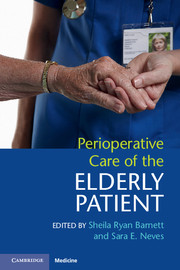Book contents
- Perioperative Care of the Elderly Patient
- Perioperative Care of the Elderly Patient
- Copyright page
- Dedication
- Contents
- Contributors
- Preface
- Section 1 Background
- Section 2 General Health and Illness
- 3 The Perioperative Management of Hypertension in the Elderly
- 4 Heart Failure
- 5 Dementia
- 6 Postoperative Cognitive Issues
- 7 Renal and Metabolic Aging
- 8 Frailty and Functional Assessment
- Section 3 Intraoperative Considerations
- Section 4 Postoperative Issues
- Index
- References
3 - The Perioperative Management of Hypertension in the Elderly
from Section 2 - General Health and Illness
Published online by Cambridge University Press: 06 January 2018
- Perioperative Care of the Elderly Patient
- Perioperative Care of the Elderly Patient
- Copyright page
- Dedication
- Contents
- Contributors
- Preface
- Section 1 Background
- Section 2 General Health and Illness
- 3 The Perioperative Management of Hypertension in the Elderly
- 4 Heart Failure
- 5 Dementia
- 6 Postoperative Cognitive Issues
- 7 Renal and Metabolic Aging
- 8 Frailty and Functional Assessment
- Section 3 Intraoperative Considerations
- Section 4 Postoperative Issues
- Index
- References
- Type
- Chapter
- Information
- Perioperative Care of the Elderly Patient , pp. 25 - 37Publisher: Cambridge University PressPrint publication year: 2018



